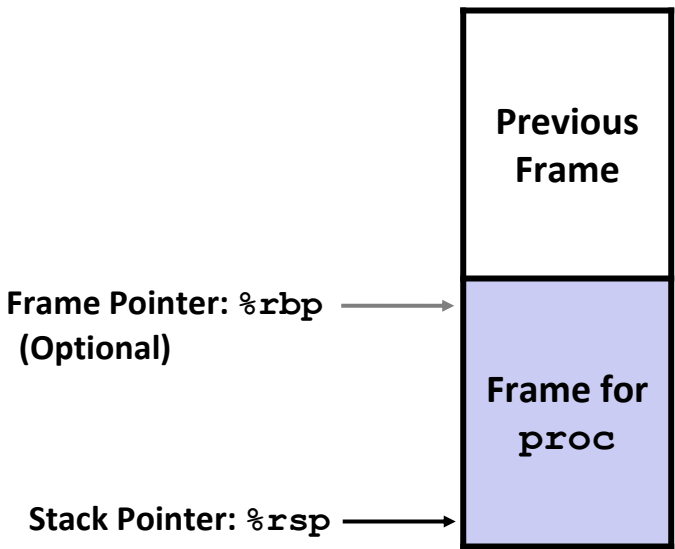Machine-Level Programming III: Procedures¶
约 405 个字 41 行代码 2 张图片 预计阅读时间 3 分钟 共被读过 次
📅 15-213/15-513: Introduction to Computer Systems | 5th Lecture, Sept 10, 2024
📖 Bryant and O’Hallaron, Computer Systems: A Programmer’s Perspective, Third Edition
Today’s Agenda¶
- Mechanisms in Procedures
- Stack Structure
- Calling Conventions
- Passing Control
- Passing Data
- Managing Local Data - x86-64 Implementation
- Examples & Activities
Mechanisms in Procedures¶
What’s Needed?¶
- Passing Control
- Jump to the beginning of procedure code.
- Return to the original point after execution.
- Passing Data
- Procedure arguments.
- Return value.
- Memory Management
- Allocate during execution.
- Deallocate upon return.
📌 Key Insight: All mechanisms are implemented via machine instructions, with choices defined by the Application Binary Interface (ABI).
x86-64 Stack¶
Structure & Operations¶
- Region of Memory Managed with Stack Discipline:
- Grows toward lower addresses.
%rsp(Stack Pointer) holds the address of the top element.
Push Operation¶
Pop Operation¶
Procedure Control Flow¶
Call and Return Instructions¶
call Label:- Push return address (next instruction) onto the stack.
- Jump to
Label. ret:- Pop return address from the stack.
- Jump to that address.
💡 Example:
# Call example
400544: call 400550 # Push return address (400549) and jump to 400550
400549: mov %rax, (%rbx)
# Return example
400557: ret # Pop address 400549 and jump back
Code Examples¶
Example 1: multstore and mult2¶
C Code:
void multstore(long x, long y, long *dest) {
long t = mult2(x, y);
*dest = t;
}
long mult2(long a, long b) {
long s = a * b;
return s;
}
Assembly:
| multstore (Caller) | mult2 (Callee) |
|-----------------------|-------------------|
| asm |asm |
| 400540: push %rbx | 400550: mov %rdi, %rax |
| 400541: mov %rdx, %rbx| 400553: imul %rsi, %rax |
| 400544: call 400550 | 400557: ret |
| 400549: mov %rax, (%rbx)| |
| 40054c: pop %rbx | |
| 40054d: ret | |
| |
📝 Analysis:
- multstore saves %rbx (callee-saved register) before calling mult2.
- Return value (s) is stored in %rax and written to *dest.
Stack Frames & Recursion¶
Stack Frame Structure¶
- Contents:
- Return address.
- Local variables.
- Saved registers.
- Temporary storage.
Recursive Example¶
Assembly:
pcount_r:
movl $0, %eax
testq %rdi, %rdi
je .L6
pushq %rbx
movq %rdi, %rbx
andl $1, %ebx
shrq %rdi
call pcount_r
addq %rbx, %rax
popq %rbx
.L6:
rep; ret
📌 Key Observations:
- Recursion uses stack frames for isolation.
- %rbx (callee-saved) preserves intermediate values across calls.
Register Usage Conventions¶
x86-64 Linux Register Roles¶
| Register | Role | Saved By |
|---|---|---|
%rax | Return value | Caller |
%rdi-%r9 | Arguments | Caller |
%rbx, %r12-15 | Callee-saved | Callee |
%rsp | Stack pointer | Callee |
⚠️ Note: Callee-saved registers must be preserved across function calls!
Activity Time!¶
Activity 2: Problems 6-9¶
- Setup:
- Tasks:
- Analyze stack behavior during nested calls.
- Trace register usage in recursive functions.
Quiz Time!¶
Sample Question¶
Q: What happens if you call mult2(y, x) instead of mult2(x, y) in multstore?
A: The arguments x and y are passed in %rdi and %rsi, respectively. Swapping them would reverse the multiplication order (e.g., y * x instead of x * y), but the result remains the same due to commutativity.
Key Takeaways¶
- Stack Discipline ensures proper nested execution and memory management.
- Calling Conventions (caller/callee-saved registers) prevent data corruption.
- Recursion leverages stack isolation for multiple instantiations.
🚀 Next: Dive into buffer overflows and advanced stack manipulation!

